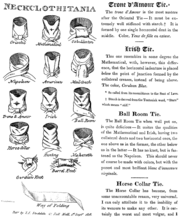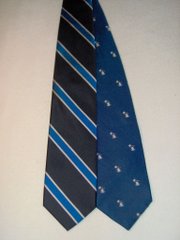Necktie
2007 Schools Wikipedia Selection. Related subjects: Everyday life
The necktie (or tie) is a long piece of woven or knitted material worn around the neck, under the shirt collar and knotted at the throat with the blades resting on the shirt front. The modern necktie, ascot and bow tie, are descended from the cravat. Ties are mainly worn by men as a regular part of office attire, formal wear or uniform. A few women also wear ties as part of a uniform (e.g. military, school), office attire or as a fashion accessory.
Cravat
A cravat is the neckband forerunner of the modern, tailored necktie. From the end of the 16th century, the term "band" applied to any long-strip neckcloth that was not a " ruff"; the ruff — a starched, pleated white linen strip — started its fashion career earlier in the 16th century as neckcloth that could be changed-a-fresh to keep the neck of a doublet from becoming too-soiled or as a bib or a napkin. A "band" could indicate a plain, attached shirt collar or a detachable "falling band" that draped over the doublet collar.
The modern cravat originated in the 1630s. Like most men's fashions, between the 17th century and World War I, it had a military origin. In the reign of Louis XIII of France, Croatian mercenaries were enlisted to a regiment supporting the King and Cardinal Richelieu against the Duc de Guise and the Queen Mother, Marie de Medici. The traditional military kit of the Croats aroused parisian curiosity in and about the unusual, picturesque scarves distinctively knotted about their necks. The scarves were made of cloths ranging from the coarse-finish material of common soldiers, to the fine linens and silks of the officers' cravats. The word "cravat" derives from the French cravate; many sources state it is a French corruption of "Croat" — Croatian "Hrvat" — however evidence shows the word use in 14th century France and in 16th century Italy. In a ballad, French writer Eustache Deschamps (c. 1340–1407), wrote the phrase "faites restraindre sa cravate" ("pull his cravat tighter").
Considering the interdependency of many European regions (particularly the French) with the Venetian Empire, and that said empire once occupied most of Croatian coast, cross-culturalization would not be unprecedented. Whatever the word's origin, the new element of male dress became known as a cravate and the French quite readily surrendered the starched linen ruff and adopted the new neck fashion of loose cravates of linen or muslin with broad lace edges.
On returning to England from exile, in 1660, Charles II took back with him the latest, new word in fashion:
- "A cravatte is another kind of adornment for the neck being nothing else but a long towel put about the Collar, and so tyed before with a Bow Knott; this is the original of all such Wearings; but now by the Art and Inventions of the seamsters, there is so many new ways of making them, that it would be a task to name, much more to describe them". (Randle Holme, Academy of Armory and Blazon, 1688.)
A gentleman's cravat would be made of fine lace. Grinling Gibbonsthe famous carver and sculptor, carved a realistic cravat from white limewood.
During the wars of Louis XIV of 1689– 1697, except for court occasions, the flowing cravat was replaced with the more current and equally military "Steinkirk", named for the Battle of Steenkerque in 1692. The Steinkirk was a long, narrow, plain or lightly trimmed neckcloth worn with military dress, wrapped once about the neck in a loose knot, with the lace of fringed ends twisted together and tucked out of the way into a button-hole (coat or waistcoat). The steinkirk proved popular with both men and women until the 1720s.
The macaronis reintroduced the flowing cravat in the 1770s, and the manner of a man's knotting it became an indicative of his personal taste and sense of style, to such extent that, after Waterloo, the neckwear, itself, was referred to as a "tie".
Tie variants
The cravat also spawned the following variants which are still worn today:
- 19th century: Bow tie; the process of the cravat changing into the bow was gradual, and a definite line is difficult to draw.
- 1850s: Four-in-hand, see below; also known as the "long tie", it is the variety most people mean when they just say "tie".
- 1880s: Ascot tie.
- 1940s: Bola tie (also called a string tie or bolo tie); a tie from the Southwest United States consisting of a cord with a clasp.
- Clip-on tie: see Clip-on tie
Four-in-hand
The four-in-hand necktie was fashionable in Britain in the 1850s. Early neckties were simple, rectangular cloth strips cut on the square, with square ends. The name "four-in-hand" originally described a carriage with four horses and a driver; it also later was the name of a gentlemen's club in London. Some etymologic reports state that carriage drivers knotted their reins with a four-in-hand knot (see below), whilst others claim the carriage drivers wore their scarves kotted in the four-in-hand manner, but, most likely, members of the club began wearing their neckties so knotted, thus making it fashionable. In the latter half of the 19th century, the four-in-hand knot and the four-in-hand necktie were synonymous. As fashion changed from stiff shirt collars to soft, turned-down collars, the four-in-hand necktie knot gained popularity; its sartorial dominance rendered the term "four-in-hand" redundant usage, shortened "long tie" and "tie".
In 1926, Jesse Langsdorf from New York introduced ties cut on the bias (US) or cross-grain (UK), allowing the tie to evenly fall from the knot without twisting; this also caused any woven pattern such as stripes to appear diagonally across the tie.
There are four main knots used to knot neckties. The simplest, the four-in-hand knot, probably is used by the majority of wearers. The others (in order of difficulty) are the Pratt knot (the Shelby knot), the half-Windsor knot, and the Windsor knot (also erroneously called the "double-Windsor"). The Windsor knot is the thickest knot of the four, since its tying has the most steps. The Windsor knot is named after the Duke of Windsor, although neither its inventor nor user. The Duke did favour a voluminous knot, however he achieved such by having neckties specially made of thicker cloths. In the late 1990s, two researchers, Thomas Fink and Yong Mao of Cambridge University's Cavendish Laboratory, used mathematical modelling to discovered that eighty-five (85) knots (within the constraints of wearing a necktie) are possible with a conventional tie. They found that in addition to the four well-known knots, six other knots have aesthetically pleasing results.
Today, four-in-hand ties are part of men's formal clothing in both Western and non-Western societies, particularly for business. They have also found their way to the wardrobes of trail-blazing, fashionable women.
Four-in-hand ties are generally made from silk or cotton. They appear in an unlimited number of colors and patterns, notably striped (diagonally) and paisley.
Some psychologists think that wearing a long necktie is a man's subconscious effort to draw female eyes towards his genitalia.
Seven fold tie
The seven-fold four-in-hand necktie is a more expensive necktie construction method. The method was almost forgotten, but revived after the austerity of the Great Depression. These ties, although they seldom carry a designer label, often sell for a minimum of $160 USD.
The seven-fold necktie construction method was originally how ties were constructed. No liner is used, be it wool, cotton, or canvas, and rarely any silk that has a pattern not woven in. The construction is, by far, the most simple among of necktie construction; however it requires almost an hour to produce a necktie, whereas a typical department store tie can require a third of an hour. A square yard of silk is folded to seven sections of silk between the folds. The edges of the cloth are saddle-stitched to prevent the edges fraying. Then a long, thick strand of twine or silk fastens the folds. The resulting seven-fold four-in-hand necktie is distinctive.
The seven-fold tie is durable and luxurious; its weight and body derive exclusively from the layering of silk. This gives the necktie a distinguishable, consistent, and noticeable dimple, which is the crease that forms just below the knot when formed a certain way. Seven-folds are resilient; oftentimes one discovers that a common necktie is permanently furrowed if its knot is left tied for longer than the work day, but this does not happen with a seven-fold four-in-hand necktie.
Designers may seek to take advantage of the seven-fold's name and produce a hybrid namesake necktie with some aesthetic similarities, but none of the practical virtues. These still contain liners, and are not made solely of silk. Normally, they have the series of folds that is observable at the bottom end of the tie, however, careful examination of thickness at mid-tie exposes the sudden end of the silk folds. Comparatively, these faux seven-fold neckties don't behave as do true seven-fold four-in-hand neckties. Despite being constructed of the same high-quality silks as seven-folds, they knot like regular lined ties. Such neckties are known as 'double four folds'.
Seven-fold neckties are distinguished by the absence of secondary material, such as a lining visible between the layers or a sudden change in consistency along the length of the body. Generally, the necktie's back shows the fabric's inverse weave pattern.
Clip-on tie
The clip-on tie is a tie (bow tie or four in hand) which is permanently tied into its knot, and which is fixed only to the front of the shirt collar by a metal clip. It is primarily a 20th-century innovation. They are widely considered stylistically inferior, but are sometimes required in professions such as law enforcement where it would be dangerous for the wearer to have a tie that an assailant could use to choke him.
Ties as signs of membership
The use of coloured and patterned neckties indicating the wearer's membership in a club, military regiment, school, et cetera, dates only from late-nineteenth century England. The first, definite occurrence was in 1880, when Exeter College, Oxford rowers took the College-colour ribbons from their straw boaters and wore them as neckties (knotted four-in-hand), and then went on to order a proper set of ties in the same colours, thus creating the first example of a College necktie.
Soon other colleges followed suit, as well as schools, universities, and clubs. At about the same time, the British military moved from dressing in brightly and distinctively coloured uniforms to subdued and discreet uniforms, and they used neckties to retain regimental colours.
The most common pattern for such ties was, and remains, diagonal stripes of alternating colours (running down the tie from the left in the UK and most of Europe, and running down from the right in the U.S.). A frequent alternative is either a single emblem or a crest centred and placed where a tie pin normally would be, or a repeated pattern of such motifs. Sometimes, both types are used by an organisation, either simply to offer a choice or to indicate a distinction among and levels of membership. Occasionally, a hybrid design is used, in which alternating stripes of colour are overlaid with repeated motif pattern.
Many British schools use variations on their basic necktie to indicate the wearer's age, house, status (e.g. prefect), or participation in competition (especially sports). Usually, the Old Boys and Girls ( alumni) wear a different design.
In the late 1970s, at the time of the Iranian Islamic Revolution, the mainstream U.S. press labelled Islamic fundamentalist hardline revolutionaries "turbans", and the modernist moderates "neckties". Culturally, in theocratic Iran, neckties have been denounced as decadent, un-Islamic, and symbolic of the Western oppression. Since then, most Iranian men have worn long-sleeved shirts with collars, but not neckties.
Ties and associated health issues
The debate between proponents and opponents of the wearing of neckties generally centre on issues of conformity, expectation, and expression. Frank Lloyd Wright said of great architecture (himself quoting another great architect, Louis Sullivan, who was also his mentor), " Form follows function". Applied to fashion, the tie's function as decoration stands criticised by the same principle. Arizona State University recently passed a resolution (2005) to have no discrimination based upon gender preferences, including cross-gender choices. However, as it takes some time to change policies and sentiments, they retained a rule requiring all men to wear ties and all women to wear hose and heels in the Office of the President for any ambassadorship visits or official meetings. Some men have been turned down for employment and even fired with or without explanation after appearing without the "expected" tie. For women, on the other hand ties are considered used to classed as 'improper' but due to the sexism issue, more and more employers are forcing women to wear ties to create a unified dress code.
Opponents of necktie wearing have cited risks associated with the wearing of neckties as an argument for discontinuing the practice. These risks have primarily involved entanglement, infection, and vascular constriction. The risk of entanglement is generally well understood by people working around machinery or in situations where person-to-person confrontation may occur (e.g., police and prison personnel, and in certain medical fields). The answer is generally to avoid wearing ties, or use the clip-on variety which detach from the wearer when grabbed. The risk of cross-infection of patients by doctors wearing ties is being treated seriously by hospitals, it being noted that ties are cleaned less often than most items of clothing and can carry bacteria. Doctors routinely lean across patients and ties frequently come into contact with patients, therefore bow ties have traditionally been popular with doctors. The risk of vascular constriction, in cases where ties are worn with over-tight collars, has been noted. Studies have shown an increase in intra-ocular pressure in these cases which can worsen the condition of people with already weakened retinas. People with glaucoma should exercise special care. In all cases sensible precautions can mitigate these risks; the danger lies in lack of awareness of the risks. Paramedics performing basic life support remove the tie from a victim as one of the very first steps when a victim is unconscious or has difficulty breathing to ensure it does not compromise the airway.
Anti-tie sentiment
Removing the necktie as a social and sartorial requirement (and in some cases the forbidding of ties) is a modern trend that historians attribute to the rise of popular culture in the 1960s. While still common as late as 1966, over the years 1967 to 1969, the necktie began falling completely out of fashion nearly everywhere, except where required. After a brief fashion resurgence in the 1980s, the 1990s saw the appearance of Internet-based (or dot-com) companies, where most workers did not feel the need for fashion when facing clients, since the business's public image and appearance was websites rather than face-to-face meetings. There also was a sentiment of independence (general liberalism) and a new way of doing things.
Large teams of telephone-salespeople also were increasing as pools of workers. Many such men and women were required to wear neckties, because it was perceived as improving work attitudes, morale, and sales. Casual Fridays became a very popular tradition in that time, in which employees were not required to wear ties on Fridays, and then — increasingly — on other, announced, special days. Some businesses extended casual-dress days to Thursday, and even Wednesday; others required neckties only on Monday (to start the work week). Eric Crown, CEO of Insight Direct, which was beginning to effect substantial on-line sales via website, along with more than $1 billion yearly dollars telephone sales, announced one morning, in 1995, that none of its 800 telephone salesmen would any longer be required to wear a necktie. After studying casual-dress day sales patterns, management announced the decision by having each salesman's necktie cut in half with scissors, by the receptionist, as they entered the workplace lobby.
Tie racks
Ties are popularly given as gifts and wearers often accumulate a large collection. While a man's selection of suit and shirt is somewhat restricted for business wear, he usually faces more difficulty in choosing a tie. Even a conservative dresser may entertain a dozen possibilities and these must be considered in light of the day's other clothing. This daily chore has given rise to the tie rack. These may be simple panels of pins or elaborate revolving, motorized, illuminated gadgets.




